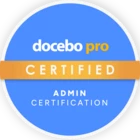So I’m just hoping someone else here has a similar situation and is willing to share ideas on a solution.
Our docebo platform is mostly for product education, so new customers can log on and take courses while they’re going through onboarding and implementation.
We have an enterprise setup with three domains, because we have three different user types.
- Internal employees who log on using a company SSO
- Product #1 customers who log in using a different SSO
- Product #2 customers who don’t have an a SSO and have their accounts created by an admin
Internal employees are supposed to be recommending courses to their clients for onboarding and implementation. The problem is, they can’t just copy and paste a course link to the client, that will direct the customer to the employee domain and they’ll get an error.
So I have a separate page in our internal confluence with descriptions of all the courses, topics covered, and a customer domain link. The idea is that internal people can browse that, and send those links to their clients.
This feels inefficient, and it’s causing friction with getting our internal users to adopt our Docebo platform and see it as a real resource for their clients.
Any ideas? At this point it feels like the employee domain is causing more issues than it’s solving (yes, it’s easier for them to log in via SSO, but then they have to go to an external resource to actually do their jobs).


